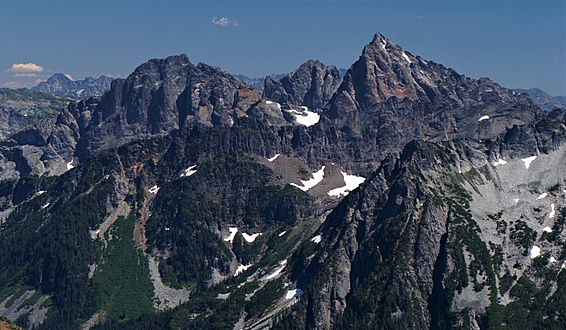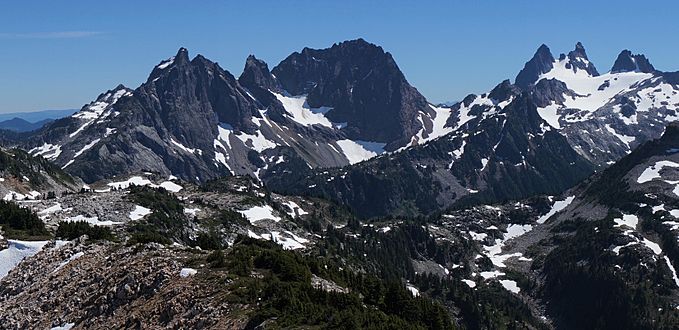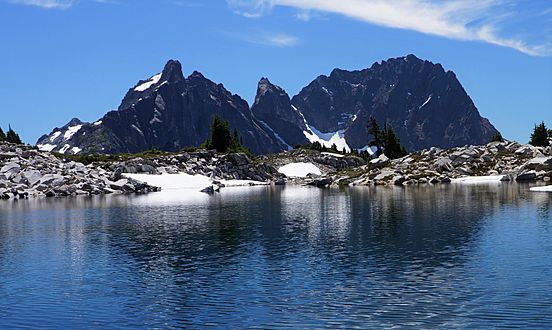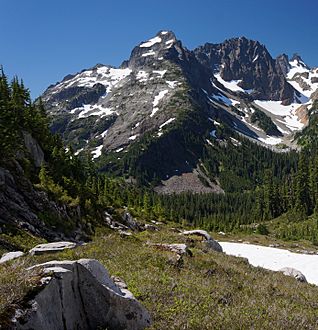Little Big Chief Mountain facts for kids
Quick facts for kids Little Big Chief Mountain |
|
|---|---|
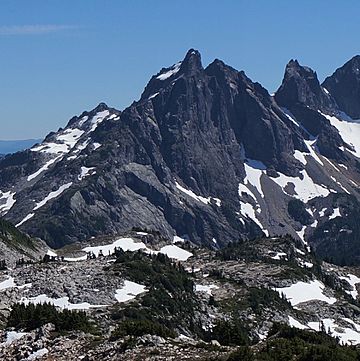
North aspect from Otter Point
|
|
| Highest point | |
| Elevation | 7,225 ft (2,202 m) |
| Prominence | 505 ft (154 m) |
| Isolation | 0.69 mi (1.11 km) |
| Parent peak | Summit Chief Mountain (7,464 ft) |
| Geography | |
| Location | King County / Kittitas County Washington state, U.S. |
| Parent range | Cascade Range |
| Topo map | USGS Big Snow Mountain |
| Climbing | |
| First ascent | 1939, Fred Beckey |
| Easiest route | Northeast Face class 3-4 Scrambling |
Little Big Chief Mountain is a tall peak, about 7,225 feet (2,202 meters) high. It sits right on the border between King County and Kittitas County in Washington state.
This mountain is part of the beautiful Alpine Lakes Wilderness. It's managed by the Mount Baker-Snoqualmie National Forest. You can find it about ten miles northeast of Snoqualmie Pass, right on the top of the Cascade Range. Rain and snowmelt from the west side flow into the Snoqualmie River. Water from the east side goes into the Yakima River.
Its closest taller neighbor is Summit Chief Mountain, about 0.7 miles (1.1 km) away. Chimney Rock is also nearby, about 2.2 miles (3.5 km) to the southwest. The first time people climbed to the top was in August 1939. This group included Fred Beckey, Wayne Swift, Joe Barto, and Campbell Brooks. The mountain was named after Lorenz A. Nelson in 1925. He was a famous mountaineer who was the first to climb many peaks, like Mount Olympus.
Mountain Weather and Climate
Little Big Chief Mountain is in a "marine west coast" climate zone. This means it's near the ocean, which affects its weather. Most weather systems come from the Pacific Ocean. They travel northeast towards the Cascade Mountains.
When these weather systems hit the tall Cascade Mountains, they are forced to rise. This makes them drop their moisture as rain or snow onto the mountains. This process is called Orographic lift. Because of this, the west side of the Cascades gets a lot of rain and snow, especially in winter.
In winter, the weather is often cloudy. But in summer, high-pressure systems over the Pacific Ocean bring clear skies. The snow here tends to be wet and heavy. This can sometimes lead to avalanche danger. The best time to visit or climb this mountain is usually from July through September.
How the Mountains Were Formed
The Alpine Lakes Wilderness has very rugged land. You'll see jagged peaks, deep valleys carved by glaciers, and tall granite walls. There are also over 700 mountain lakes.
Long ago, huge geological events created this varied landscape. These events caused big changes in elevation across the Cascade Range. These changes led to different climates and types of plants in the area. The land here ranges from about 1,000 feet (300 meters) high to over 9,000 feet (2,700 meters) on Mount Stuart.
The Cascade Range started forming millions of years ago. This was during a time called the late Eocene Epoch. The North American Plate was slowly moving over the Pacific Plate. This movement caused volcanoes to erupt and create new rock. Also, small pieces of the Earth's crust, called terranes, helped form the North Cascades about 50 million years ago.
About two million years ago, during the Pleistocene period, glaciers repeatedly moved across the land. They scraped away rock and left behind debris. The last glaciers in the Alpine Lakes area started melting about 14,000 years ago. By 10,000 years ago, they had moved north of the Canada–US border. The river valleys here have a U-shape because of these glaciers. The combination of land rising (uplift), cracks in the Earth's crust (faulting), and glaciers created the tall peaks and deep valleys you see in the Alpine Lakes Wilderness today.
Gallery
-
Little Big Chief is on the left, and Summit Chief is on the right. This view is from Big Snow Mountain.




